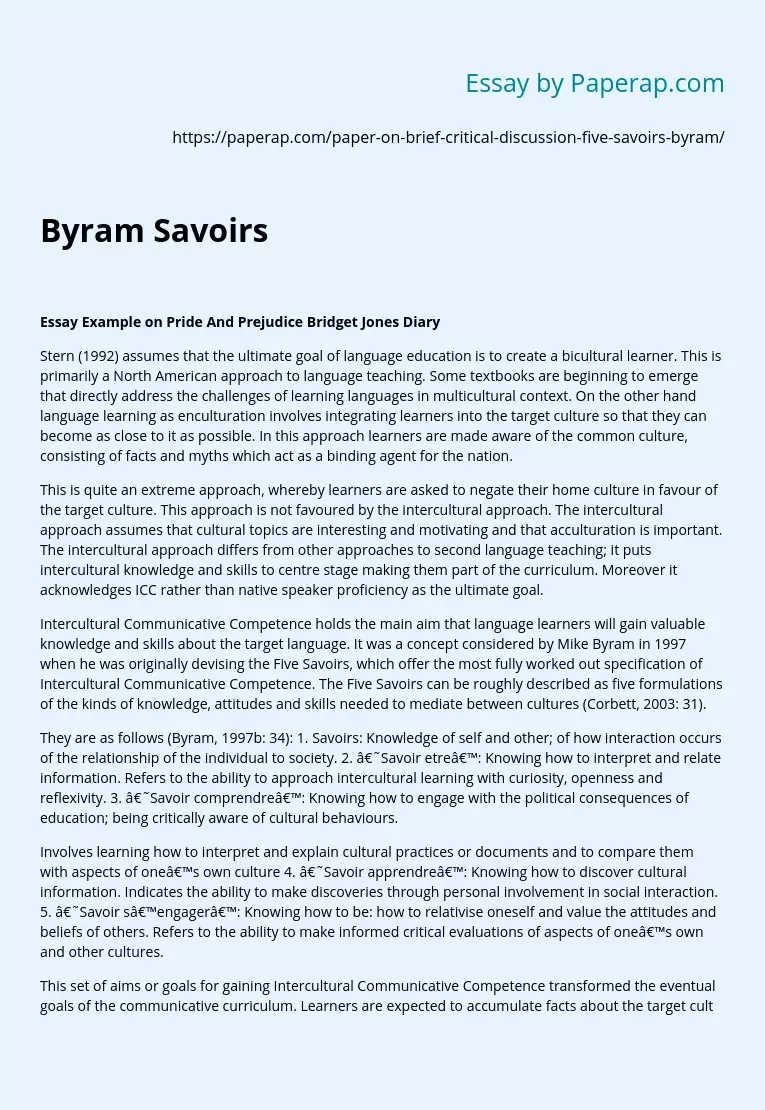Language Education Goals: Creating a Bicultural Society
Essay Example on Pride And Prejudice Bridget Jones Diary
Stern (1992) assumes that the ultimate goal of language education is to create a bicultural learner. This is primarily a North American approach to language teaching. Some textbooks are beginning to emerge that directly address the challenges of learning languages in multicultural context. On the other hand language learning as enculturation involves integrating learners into the target culture so that they can become as close to it as possible. In this approach learners are made aware of the common culture, consisting of facts and myths which act as a binding agent for the nation.
This is quite an extreme approach, whereby learners are asked to negate their home culture in favour of the target culture. This approach is not favoured by the intercultural approach. The intercultural approach assumes that cultural topics are interesting and motivating and that acculturation is important. The intercultural approach differs from other approaches to second language teaching; it puts intercultural knowledge and skills to centre stage making them part of the curriculum.
Moreover it acknowledges ICC rather than native speaker proficiency as the ultimate goal.
Intercultural Communicative Competence holds the main aim that language learners will gain valuable knowledge and skills about the target language. It was a concept considered by Mike Byram in 1997 when he was originally devising the Five Savoirs, which offer the most fully worked out specification of Intercultural Communicative Competence. The Five Savoirs can be roughly described as five formulations of the kinds of knowledge, attitudes and skills needed to mediate between cultures (Corbett, 2003: 31).
They are as follows (Byram, 1997b: 34): 1. Savoirs: Knowledge of self and other; of how interaction occurs of the relationship of the individual to society. 2. ‘Savoir etre’: Knowing how to interpret and relate information. Refers to the ability to approach intercultural learning with curiosity, openness and reflexivity. 3. ‘Savoir comprendre’: Knowing how to engage with the political consequences of education; being critically aware of cultural behaviours.
Involves learning how to interpret and explain cultural practices or documents and to compare them with aspects of one’s own culture 4. ‘Savoir apprendre’: Knowing how to discover cultural information. Indicates the ability to make discoveries through personal involvement in social interaction. 5. ‘Savoir s’engager’: Knowing how to be: how to relativise oneself and value the attitudes and beliefs of others. Refers to the ability to make informed critical evaluations of aspects of one’s own and other cultures.
This set of aims or goals for gaining Intercultural Communicative Competence transformed the eventual goals of the communicative curriculum. Learners are expected to accumulate facts about the target culture, and know something about how people from the target culture might be expected to behave. It is important that the five savoirs are not considered as isolated components but rather as component pieces that are integrated with the various dimensions of communicative competence (Sercu, 2002: 63)
Bibliography Byram, M.(1997b) Teaching and Assessing Intercultural Communicative Competence Clevedon: Multilingual Matters Corbett, J. (2003) An Intercultural Approach to English Language Teaching Clevedon: Multilingual Matters Hymes, D. (1972) “On communicative competence. ” Pride, J. B. , Holmes, J. Sociolinguistics Harmondsworth: Penguin, 269-293 Sercu, L. (2002) “Autonomous Learning and the Acquisition of Intercultural Communicative Competence: Some Implications for Course Development” Language Culture and Curriculum Volume: 15 Number: 1, 61-74.
Language Education Goals: Creating a Bicultural Society. (2019, Nov 27). Retrieved from https://paperap.com/paper-on-brief-critical-discussion-five-savoirs-byram/

